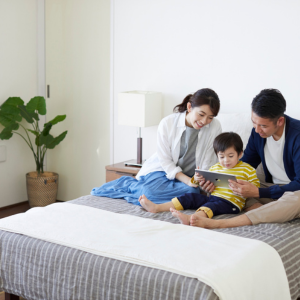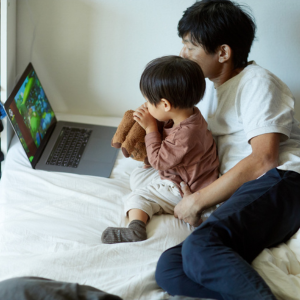Managing your child’s screen time in today’s digital world is no easy task. From cartoons on tablets to educational apps on smartphones, children are surrounded by screens from an early age. As a new mom, you might be wondering how much screen time is too much, and more importantly, how to balance it without meltdowns or mom guilt. This guide offers practical, research-based, and realistic strategies to help you understand, manage, and improve your child’s screen time habits starting from infancy through early childhood.
Table of Contents
What Is Screen Time?
Screen time is the amount of time your child spends using digital devices like TVs, tablets, smartphones, computers, or gaming consoles. It includes everything from watching cartoons and playing games to video calls and online learning.
There are two main types of screen time:
- Passive screen time: Watching TV or videos without interacting
- Active screen time: Playing educational games or using apps that require thinking and response
While some screen time can be fun or educational, too much of it—especially passive use—can affect your child’s sleep, mood, learning, and physical health. That’s why it’s essential to balance screen time with real-world activities, such as playing outside, reading, and engaging in face-to-face interactions.

Why Managing Your Child’s Screen Time Matters
Screens are everywhere—but that doesn’t mean they’re harmless. While technology offers learning and entertainment opportunities, excessive screen time can lead to serious developmental and behavioral issues, especially in young children. Here’s why it’s crucial to manage your child’s screen time carefully:
- Overexposure to screens can delay speech and language development
- Increased screen time is linked to obesity and poor sleep in toddlers
- Screens can reduce attention spans and hinder social interaction
- Excess screen use often replaces physical activity and creative play
What Is a Healthy Child’s Screen Time?
Healthy screen time supports your child’s learning and development without harming their physical or emotional well-being. Here’s what it looks like:
- Includes educational content like learning apps or age-appropriate videos
- Is supervised by a parent or caregiver, especially for younger children
- Doesn’t replace sleep, outdoor play, or face-to-face interaction
- Is limited by age (e.g., under 2 years: little to no screen time)
- Encourages active participation, not just passive watching
- Is used as a tool for learning or bonding, not just entertainment
- Happens in safe spaces and at the right times (e.g., not before bed)

How Child’s Screen Time Affects the Brain
Excessive screen time, especially in early childhood, can affect brain development in several ways. Here’s how screens may impact your child’s brain:
- Delays in speech and language: Too much screen time can reduce real-life conversations, which are vital for language development
- Shortened attention span: Fast-paced content can make it harder for children to focus on slower, real-world activities
- Sleep problems: Blue light from screens can disrupt melatonin levels, making it hard for kids to fall asleep
- Reduced social skills: Screen time can take away from face-to-face interaction, limiting emotional and social development
- Less creative thinking: Passive watching reduces imaginative play and problem-solving, which are key to brain growth
- Overstimulation: Bright colors, loud sounds, and fast edits can overwhelm a child’s developing nervous system
What Are the Symptoms of Too Much Child’s Screen Time?
Too much screen time can affect your child’s body, mind, and behavior in ways you might not expect. Watch for these common signs:
- Irritability or tantrums when screens are taken away
- Trouble sleeping or falling asleep late
- Frequent headaches or eye strain
- Poor posture or physical inactivity
- Lack of interest in outdoor play or toys
- Reduced attention span or difficulty focusing
- Delayed speech or language development (especially in toddlers)
- Social withdrawal or less interest in talking and bonding
- Increased anxiety or mood swings
- Eating while distracted by screens, leading to overeating
If you notice several of these symptoms, it may be time to review your child’s screen habits and set healthier limits.
Does a Child’s Screen Time Reduce Memory?
Yes, too much Child’s Screen Time—especially passive screen use—can affect your child’s memory over time. Here’s how:
- Reduced attention: When children constantly switch between apps, videos, and games, it becomes harder for their brains to focus and store information
- Overstimulation: Bright colors and fast-paced content can overwhelm the brain, making it harder to retain what’s being watched
- Less real-world interaction: Children learn and remember best through hands-on activities, play, and conversation—not just from screens
- Interrupted sleep: Poor sleep from late-night screen use can affect the brain’s ability to form and store memories
- Dependence on screens for answers: When kids rely on Google or apps instead of thinking things through, they practice recall less, which weakens memory
While occasional screen time won’t harm memory, it’s important to keep it balanced with real-life learning activities like puzzles, reading, storytelling, and play.
Can a Child’s Screen Time Cause Depression?
Yes, too much screen time—especially unmonitored or unsupervised use—can increase the risk of depression in children. Here’s why:
- Less face-to-face interaction: Screens often replace quality time with parents, friends, and caregivers, leading to feelings of loneliness
- Sleep disruption: Poor sleep from excessive screen use can affect mood, making children more irritable, anxious, or sad
- Social comparison: Exposure to unrealistic content on social media or YouTube can lead to low self-esteem, even in young kids
- Reduced physical activity: Sedentary habits from screen overuse can negatively impact mental health and energy levels
- Overstimulation: Fast-paced games and videos can overwhelm the brain, increasing stress and emotional fatigue
While screen time alone doesn’t directly cause depression, excessive and unbalanced use—especially without adult guidance—can contribute to mental health struggles over time. Keeping screen time healthy, limited, and purposeful helps protect your child’s emotional well-being.

What Are the Behavior Issues Linked to a Child’s Screen Time?
Too much of a child’s screen time can lead to behavior problems that affect their daily routines, learning, and relationships. Here are some common behavior issues to watch for:
- Increased tantrums and mood swings, especially when screen time is limited or denied
- Difficulty focusing or paying attention during tasks like reading or listening
- Aggressive or impulsive behavior after watching fast-paced or violent content
- Reduced interest in playing, socializing, or exploring new things
- Poor frustration tolerance, leading to anger or whining when things don’t go their way
- Impatience or restlessness when not engaged with a screen
- Lack of emotional regulation, making it harder to calm down after exciting screen use
- Overdependence on screens for comfort, boredom, or entertainment
Managing your child’s screen time with healthy routines, screen-free activities, and age-appropriate content can reduce these behavior issues and support better emotional development.
Why No Screens Before Age 3?
Limiting a child’s screen time before age 3 is important because early childhood is a critical stage for brain development. Here’s why screens should be avoided or strictly limited in the first three years:
- Delays speech and language development: Babies and toddlers learn best through real-life talking and interaction—not from screens
- Reduces bonding time: Face-to-face connection with parents and caregivers builds trust, emotional security, and communication skills
- Interrupts sleep patterns: Blue light from screens can confuse the brain’s natural sleep-wake cycle, leading to poor sleep
- Limits movement and play: Real play (like crawling, walking, or stacking toys) supports brain and body development—screens don’t
- Overstimulates the brain: Fast, colorful images can overwhelm a toddler’s developing brain, leading to restlessness or irritability
- Slows attention span growth: Passive viewing teaches kids to expect constant stimulation, making it harder to focus later
To support healthy development, pediatricians recommend avoiding screen time (except for video calls) until at least age 18–24 months. After that, your child’s screen time should be slow, limited, and always supervised.
When to Start Your Child’s Screen Time?
Experts recommend delaying your child’s screen time until at least 18 to 24 months of age—and even then, it should be limited, high-quality, and always supervised. Before this age, babies learn best through real-world play, touch, sound, and face-to-face interaction.
When you do introduce your child’s screen time, keep these tips in mind:
- Start with short sessions—no more than 15–20 minutes at a time
- Choose educational and age-appropriate content
- Always co-watch or co-play to help your child understand what they’re seeing
- Avoid screens during meals, before bedtime, and in the background
- Make sure screens don’t replace real-life activities like reading, singing, or outdoor play
Starting your child’s screen time the right way can help build healthy habits from the beginning and avoid overuse later on.
15 Proven Strategies to Control My Child’s Screen Time
Controlling your child’s screen time doesn’t have to mean constant battles or saying “no” all day. With the right strategies, you can create healthy habits that work for your whole family. From setting clear limits and screen-free zones to offering fun alternatives and being a good role model, these 15 simple tips will help you guide your child toward a balanced, happy, and healthy relationship with screens.
1. Understand the Recommended Screen Time by Age
Not all screen time is equal, and age matters. Following expert guidelines helps set healthy boundaries from the beginning:
- 0–18 months: Avoid screen time entirely (except for video calls)
- 18–24 months: Only high-quality content and always with adult supervision
- 2–5 years: Limit screen use to 1 hour per day, with quality content
- 6+ years: Place consistent limits and ensure screen time doesn’t interfere with sleep, physical activity, or family time
2. Set Clear, Consistent Rules About Screen Use
Children thrive on routine, and screen time is no exception. Create house rules that define when, where, and how screens are used. For example:
- No screens during meals
- No screens an hour before bedtime
- Only educational shows on weekdays
Consistency helps children understand limits and prevents power struggles about screen time.
3. Create a Family Media Plan
Design a personalized plan that outlines screen time expectations for everyone in the household. Include:
- Daily screen time limits
- Approved apps and websites
- Screen-free zones (like the bedroom or dining area)
- Co-viewing expectations
You can use free online tools like the AAP’s Family Media Plan to get started.
4. Model Healthy Screen Habits Yourself
Children learn more from what you do than what you say. If you want to reduce your child’s screen time, start by examining your own habits. Avoid scrolling during family time, meals, or play. Instead, engage in screen-free activities like reading or outdoor walks. When kids see you choosing real-life interaction over screens, they’re more likely to follow suit.
5. Make Screens a Privilege, Not a Right
Treat screen time like dessert—it’s earned, not given freely. Encourage your child to complete tasks such as chores, homework, or outdoor play before allowing access to screens. This teaches them that screen use is balanced with responsibilities and real-life experiences.
6. Use Parental Controls and Screen Management Tools
Technology isn’t all bad—it can actually help manage itself! Use built-in tools to:
- Set time limits on apps
- Block inappropriate content
- Monitor your child’s screen usage
Popular options include Apple Screen Time, Google Family Link, Bark, and Qustodio. These tools let you supervise your child’s screen time without constantly hovering.
7. Encourage Active Screen Time vs Passive Watching
Not all screen time is wasted time. Prioritize interactive apps or programs that stimulate thinking, creativity, or learning. Look for:
- Educational games and apps
- Videos that encourage dancing or movement
- Programs that teach numbers, letters, or emotional regulation
Co-view with your child when possible and talk about what they’re watching. This transforms passive screen time into a shared learning experience.
8. Design Screen-Free Family Rituals
Create special moments where screens are completely out of the picture. Some ideas include:
- Family board game night
- Screen-free Sunday mornings
- Daily storytime before bed
These rituals create lasting memories and reinforce the value of human connection over screen interaction.
9. Replace Screen Time with Meaningful Alternatives
Boredom often leads to screen requests. Fill your child’s day with engaging, screen-free activities such as:
- Building with blocks or LEGOs
- Drawing, coloring, or simple crafts
- Pretend play with dolls, animals, or toy kitchens
- Nature walks or backyard scavenger hunts
Having a go-to list of fun alternatives makes it easier to say “no” to unnecessary screen time.
10. Watch for Screen Time Red Flags
Too much screen time can show up in subtle ways. Pay attention to signs like:
- Tantrums when screens are turned off
- Lack of interest in toys or playtime
- Trouble sleeping or increased anxiety
If you notice these signs, it may be time to reassess your child’s screen time habits and scale back gently.
11. Introduce “Tech Breaks” Throughout the Day
Break up your child’s screen time into small chunks with tech breaks in between. For example:
- 30 minutes of screen time → 15-minute play break
- Educational video → outdoor walk
These pauses prevent overstimulation and encourage a balance between virtual and real-life experiences.
12. Set Up Screen-Free Zones at Home
Keep certain areas of your home completely screen-free to promote better focus and connection. Examples include:
- Dining area (for screen-free family meals)
- Bedrooms (to improve sleep quality)
- Bathrooms (to reduce over-dependence)
Having boundaries by space helps children understand that screens have a time and place—not everywhere, all the time.
13. Allow Extra Screen Time Strategically
There will be times when extra screen time is needed—long car rides, sick days, or while you’re busy with household chores. That’s okay! Use these moments strategically by offering educational shows or interactive games. Don’t forget to return to your regular screen routine once the situation passes.
14. Talk to Your Child About Screens
Even toddlers can begin to understand why screen limits exist. Have open conversations about:
- Why screens are fun but not everything
- How too much screen time can affect health or sleep
- Why playing outside or reading is just as important
Involving your child helps them feel more in control and less resistant to limits.
15. Be Flexible and Adjust Over Time
As your child grows, their needs and understanding of screen time will evolve. Reassess rules and routines as needed. For example:
- A preschooler may benefit from co-viewing learning videos
- An older child may need time for online learning or schoolwork
- Some days may require more flexibility than others
The goal is balance—not perfection. Stay flexible while keeping the big picture in mind.
Conclusion: Creating a Healthy Balance in Your Child’s Screen Time
Managing your child’s screen time doesn’t mean cutting out technology completely—it means using it wisely. With the 15 proven strategies we covered, you can create healthy boundaries, encourage meaningful activities, and build positive screen habits from the start. From setting clear rules and screen-free zones to offering fun alternatives and being a strong role model, each step makes a big difference. As your child grows, their screen time habits will grow too—so stay consistent, stay flexible, and always keep their well-being at the heart of every decision.








